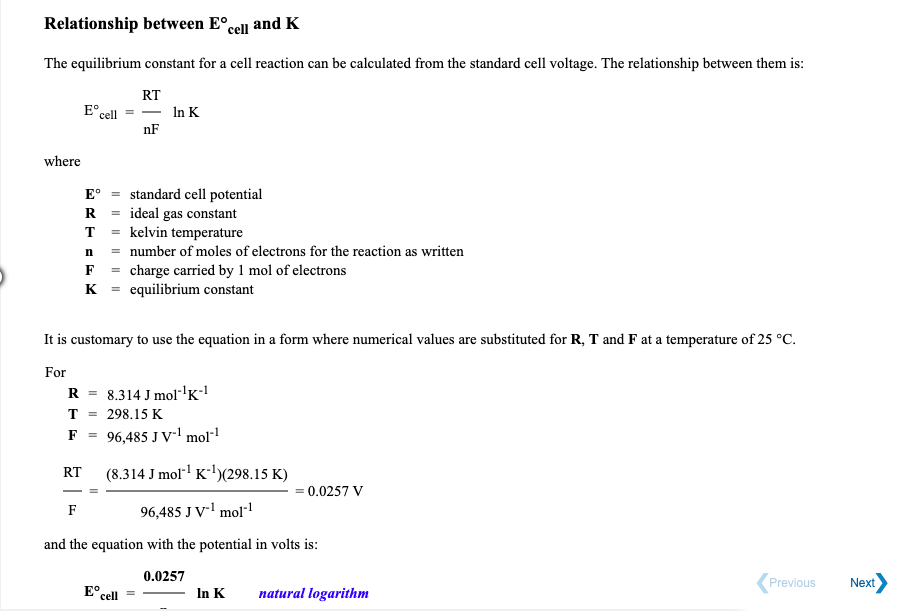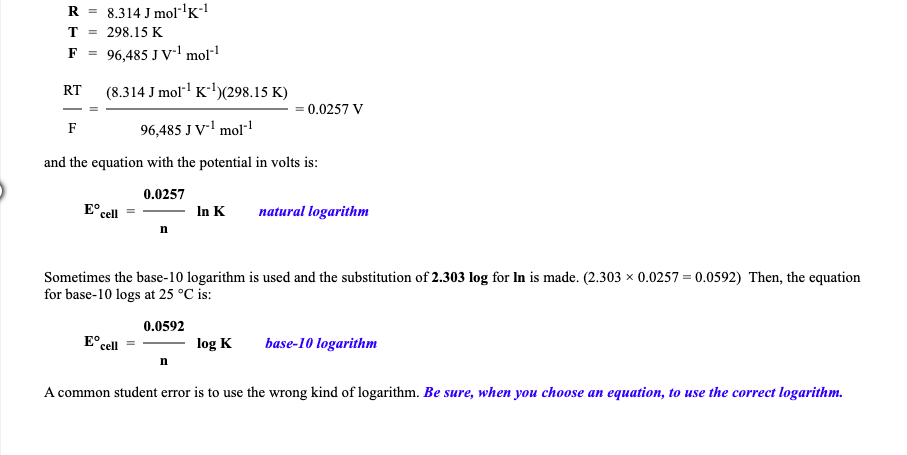Use standard reduction potentials to calculate the equilibrium constant for the reaction: Hg2+(aq) + 2Cr2+(aq)→ Hg(l) + 2Cr3+(aq) Hint: Carry at least 5 significant figures during intermediate calculations to avoid round off error when taking the antilogarithm. Equilibrium constant: ______ G° for this reaction would be _________ (greater or less ) than zero.
Use standard reduction potentials to calculate the equilibrium constant for the reaction: Hg2+(aq) + 2Cr2+(aq)→ Hg(l) + 2Cr3+(aq) Hint: Carry at least 5 significant figures during intermediate calculations to avoid round off error when taking the antilogarithm. Equilibrium constant: ______ G° for this reaction would be _________ (greater or less ) than zero.
Chemistry: Principles and Reactions
8th Edition
ISBN:9781305079373
Author:William L. Masterton, Cecile N. Hurley
Publisher:William L. Masterton, Cecile N. Hurley
Chapter17: Electrochemistry
Section: Chapter Questions
Problem 105QAP: Consider a voltaic cell in which the following reaction occurs. Zn(s)+Sn2+(aq)Zn2+(aq)+Sn(s) (a)...
Related questions
Question
Use standard reduction potentials to calculate the equilibrium constant for the reaction:
Hg2+(aq) + 2Cr2+(aq)→ Hg(l) + 2Cr3+(aq)
Hint: Carry at least 5 significant figures during intermediate calculations to avoid round off error when taking the antilogarithm.
Equilibrium constant: ______
G° for this reaction would be _________ (greater or less ) than zero.

Transcribed Image Text:Relationship between E°cell and K
The equilibrium constant for a cell reaction can be calculated from the standard cell voltage. The relationship between them is:
RT
E°.
cell
In K
nF
where
standard cell potential
= ideal gas constant
kelvin temperature
= number of moles of electrons for the reaction as written
F = charge carried by 1 mol of electrons
K = equilibrium constant
E°
R
T
n
It is customary to use the equation in a form where numerical values are substituted for R, T and F at a temperature of 25 °C.
For
R =
8.314 J mol-'K!
T
298.15 K
F =
96,485 J V' mol"1
(8.314 J mol K-)(298.15 K)
RT
= 0.0257 V
F
96,485 J V-l mol!
and the equation with the potential in volts is:
0.0257
Previous
Next
E° cell
In K
natural logarithm

Transcribed Image Text:R =
8.314 J mol"'K!
T
298.15 K
F =
96,485 J V-' mol"1
(8.314 J mol K-)(298.15 K)
RT
0.0257 V
96,485 J V' mol
F
and the equation with the potential in volts is:
0.0257
E°
cell
In K
natural logarithm
Sometimes the base-10 logarithm is used and the substitution of 2.303 log for In is made. (2.303 x 0.0257 = 0.0592) Then, the equation
for base-10 logs at 25 °C is:
0.0592
E° cell
log K
base-10 logarithm
n
A common student error is to use the wrong kind of logarithm. Be sure, when you choose an equation, to use the correct logarithm.
Expert Solution
This question has been solved!
Explore an expertly crafted, step-by-step solution for a thorough understanding of key concepts.
This is a popular solution!
Trending now
This is a popular solution!
Step by step
Solved in 3 steps

Knowledge Booster
Learn more about
Need a deep-dive on the concept behind this application? Look no further. Learn more about this topic, chemistry and related others by exploring similar questions and additional content below.Recommended textbooks for you

Chemistry: Principles and Reactions
Chemistry
ISBN:
9781305079373
Author:
William L. Masterton, Cecile N. Hurley
Publisher:
Cengage Learning

Principles of Modern Chemistry
Chemistry
ISBN:
9781305079113
Author:
David W. Oxtoby, H. Pat Gillis, Laurie J. Butler
Publisher:
Cengage Learning

Chemistry by OpenStax (2015-05-04)
Chemistry
ISBN:
9781938168390
Author:
Klaus Theopold, Richard H Langley, Paul Flowers, William R. Robinson, Mark Blaser
Publisher:
OpenStax

Chemistry: Principles and Reactions
Chemistry
ISBN:
9781305079373
Author:
William L. Masterton, Cecile N. Hurley
Publisher:
Cengage Learning

Principles of Modern Chemistry
Chemistry
ISBN:
9781305079113
Author:
David W. Oxtoby, H. Pat Gillis, Laurie J. Butler
Publisher:
Cengage Learning

Chemistry by OpenStax (2015-05-04)
Chemistry
ISBN:
9781938168390
Author:
Klaus Theopold, Richard H Langley, Paul Flowers, William R. Robinson, Mark Blaser
Publisher:
OpenStax

Physical Chemistry
Chemistry
ISBN:
9781133958437
Author:
Ball, David W. (david Warren), BAER, Tomas
Publisher:
Wadsworth Cengage Learning,


Chemistry: Principles and Practice
Chemistry
ISBN:
9780534420123
Author:
Daniel L. Reger, Scott R. Goode, David W. Ball, Edward Mercer
Publisher:
Cengage Learning